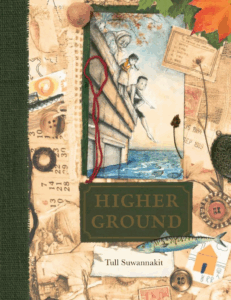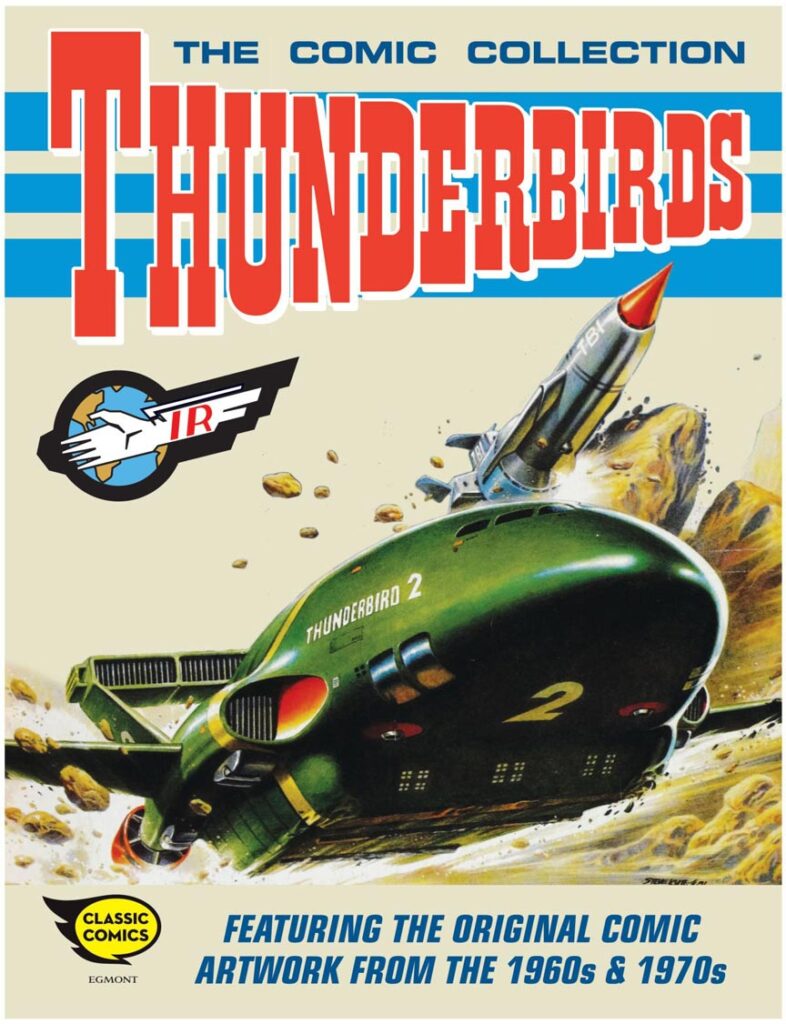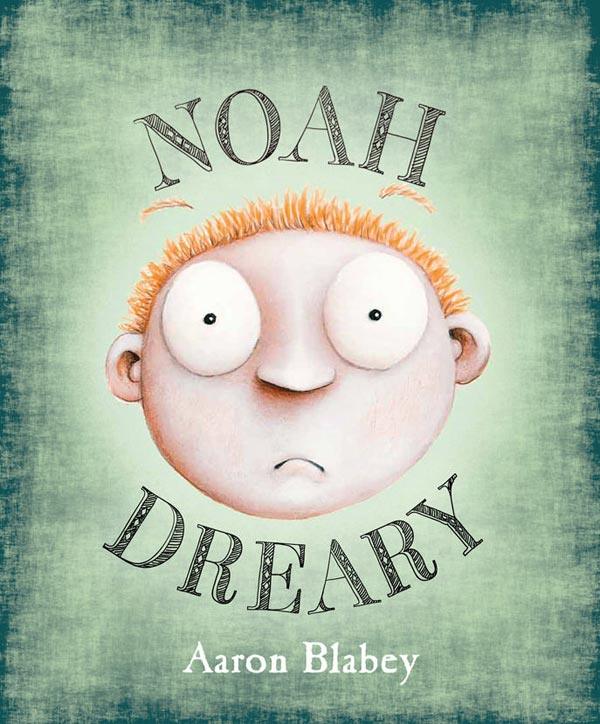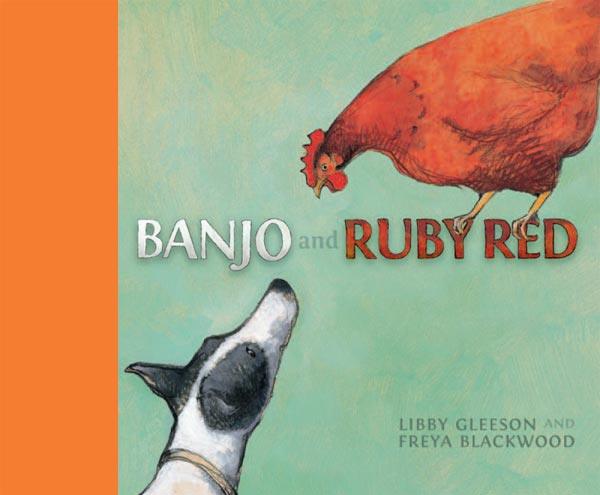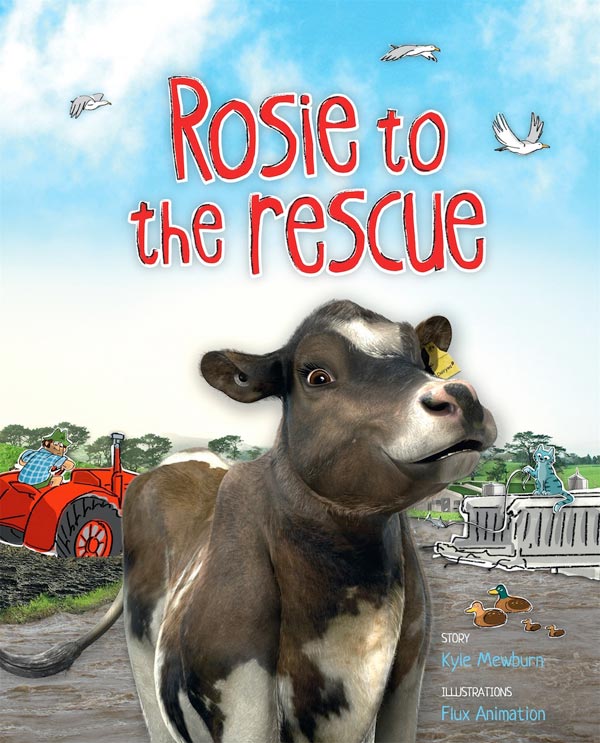Tull Suwannakit, Higher Ground, New Frontier, March 2025, 132 pp., RRP $32.99 (hbk), ISBN 9781922326997
Two children and their grandmother (and their pet rabbit) are stranded alone in a city devastated by an unprecedented flood. The opening two spreads show an almost apocalyptic scene with rain so heavy you can’t see through it, birds fleeing and lightning briefly illuminating a patch of rain-sodden landscape. Grandma calls it ‘the great flood’. The reference to climate change and the changing weather patterns, including such things as unprecedented rainfall, are implied but not laboured. There is too, an almost Biblical reference with the great flood, the stranded people and, eventually, a bird that leads the children to a new life.
Family is a strong theme in the book with the children and grandmother working together to survive – and indeed thrive – in the straitened circumstances in which they find themselves. Grandma’s wisdom and ingenuity teaches the children all sorts of useful lessons and, in this way, the book also celebrates the importance of intergenerational respect. The relationship between the three is warm and loving and the children feel safe with Grandma even when all around them is frightening.
It is she who gives them the courage eventually to build a raft and the sail off to try to find another place to live. Her selfless decision to stay behind requires a special kind of resilience from the children but it is also Grandma who has enabled them to do this. The children require special courage and strength on their journey across vast expanses of water, especially when they seem to be lost but they always remember her telling them ‘never give up hope’.
This could be seen as a graphic novel with a difference – unlike most, this book does not use dialogue ‘bubbles’ to move the story forward, nor does it use graphic designs. It does, however, often have multiple illustrations on one page and these, along with the written text, do help to move the story forward. As the storm continues, so too do the black and white illustrations. These gradually move to coloured illustrations as the storm and the rain abate. The illustrations are often complex and very detailed, especially when there is what is depicted as one of Grandma’s lessons. Other pages are wordless with the narrative being told through the illustrations themselves. The passage of time and the changing seasons are also illustrated with changing colours and there is too, a depiction, also echoed in the written text, of Grandma becoming more frail.
The book is divided into chapters such as Harvest Moon, The Raft, Beyond the Horizon and, finally, Epilogue. It is a beautifully- produced book. The collage cover is intriguing and inviting leading us to equally interesting endpapers. The slightly mottled, antique-looking paper used throughout gives the impression of a diary, an effect enhanced by the combination of illustrations, prose and ‘how to do’ instructions used throughout.
It’s a book destined to become a modern classic.
Reviewed by Margot Hillel
Luby, Miranda. The Edge of Everything. Text, 2025. 311pp. ISBN 9-781923-058-330
When we first meet Lucy, she has been startled by a plains-wanderer, an endangered bird, flying into her bedroom window. She cares for the bird overnight before taking it to a nearby animal sanctuary. Any hopes she has of getting a job there or even volunteering, quickly disappear when she meets the boss. He, unfortunately, recognizes her from a prank she and her friend Jacinta played the night before. This prank is called by the girls a ‘life bomb’, something that comes from a YouTuber they both like and is designed to give a big adrenaline rush.
Lucy, in some way, equates the bird with her brother Charlie, whom we learn, died almost a year earlier. The death has had a devastating effect on the whole family. Much of Lucy’s behaviour since has been influenced by her grief. She seems unable to motivate herself and spends a lot of time in her room. The ‘life bombs’ she devises become more extreme – she shoplifts and tries to persuade Jacinta that they should get tattoos on New Year’s Eve. Jacinta does not want to continue with this kind of reckless behaviour, however.
Lucy finds her parents’ insistence that they are fine irritating and unconvincing. She is afraid that they might separate as a result of Charlie’s death, something that makes her more uncertain and worried. She also believes that Charlie was her parents’ favourite and that she is somehow second best.
She is constantly afraid of falling into what she describes as a black hole in her mind, a terrifying image of a downward spiral. In a cathartic moment, she is able to confront this, explain what is going on and face her own fear of sudden death. It is Ben, whom she met at the animal sanctuary who brings this about.
In her grief Lucy has also pushed away a number of her closest friends as they seem to her to treat her as if she was only her grief, tiptoeing around her in case they upset her when she really wants some normality. She realises too, that her brother’s best friend, on whom she previously had a crush, really only needs her as part of his own grieving process.
In a way, this is a coming-of-age novel in which Lucy comes to understand others around her. She tells her friends how their well-meaning concern has made her feel, she develops a new understanding of her parents’ relationship and what makes a family and, while recognizing that the tragedy of her brother’s death will always be with her, feels ready to move to the next stage of her life.
Margot Hillel

